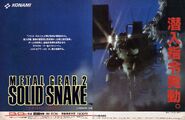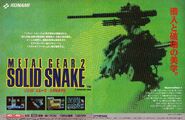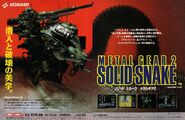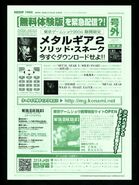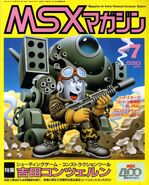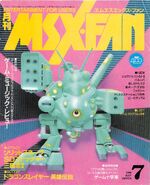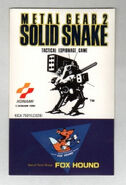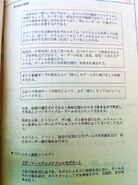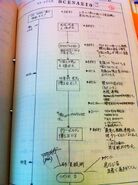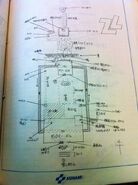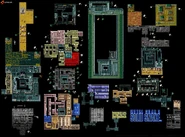| This article is about the video game, Metal Gear 2: Solid Snake. You may be looking for Metal Gear 2, the bipedal weapon featured in Snake's Revenge. |
Metal Gear 2: Solid Snake (メタルギア2 ソリッドスネーク Metaru Gia Tsū Soriddo Sunēku?, commonly abbreviated MG2) is a stealth action game that was written and directed by Hideo Kojima and developed by Konami. It is the second game released in the Metal Gear series and the seventh one chronologically. It was initially released only in Japan for the MSX2 computer on July 20, 1990. The game was re-released 14 years later, as a downloadable game for mobile phones in Japan in 2004. A North American and European version of Metal Gear 2 was released in 2006 as part of Metal Gear Solid 3: Subsistence along with the original Metal Gear.
In the game, Solid Snake must infiltrate Zanzibar Land, a heavily defended territory located in Central Asia, to rescue a kidnapped scientist and destroy the revised Metal Gear D. The game significantly evolved the stealth-based gameplay of its predecessor "in almost every way," introduced a complex storyline dealing with themes such as the nature of warfare and nuclear proliferation, and is considered "one of the best 8 bit games ever made." However, the game was not released in the Western world, due to the conflicting release of Snake's Revenge, until 16 years later.[1]
Gameplay
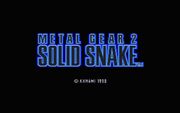
Title screen.
Metal Gear 2 builds upon and further evolves the stealth-based gameplay of its predecessor. As in the original Metal Gear, the player's objective is to infiltrate the enemy's stronghold, while avoiding detection from soldiers, cameras, infrared sensors, and other surveillance devices. The biggest change in the game was done to the enemy's behavior. Whereas the guards in the first game could see in straight lines, the guards in Metal Gear 2 can all see in a field of vision of 45 degrees. The guards can also turn their head left or right to see diagonally and move from one screen to another (instead of being stationed in one area). The enemy can also hear any noise made by the player which usually occurs when the player fires a non-silenced firearm, uses an explosive, hits on a wall or walks on certain types of terrain. If the player is discovered by the enemy, the game will be in Alert Mode and the number of life points they currently have will be displayed on the upper right side of the screen. When the enemy loses track of the player, the game enters Evasion Mode and a counter will go down. When the counter reaches zero, the game returns to normal.[1]
The player has been given new maneuvers and tools to help them remain undetected and complete the game. For example, the player can now kneel and crawl in addition to walking, allowing to player to avoid making noise, pick up land mines, and hide in tight spaces such as under desks or inside air ducts. A radar with a 3x3 grid on the upper right hand screen shows Snake's current position in the center screen (as a red dot), with enemy soldiers as white dots, allowing the player to determine what's ahead. However, the radar is disabled when the game enters Alert Mode. The radar can also be used with the mine detector equipped to determine the locations of any placed mines or fire Stinger missiles on an airborne target. Many weapons and equipment from the first game are brought over as well as new items such as robotic mice used to distract enemies, a camouflaged mat and three different types of rations with their own attributes. The player no longer needs to rescue POWs to increase their rank; instead their life energy and carrying capacity is increased each time they defeat the game's bosses.[1]
The transceiver has been greatly revamped from the first game as well. The messages the player receives are now based on their current situation and mission objective, rather than the room they're currently in, making them less fixed and more dynamic. The transceiver screen now displays Snake's face as well as the face of the character he's currently communicating with. The player can also talk to children living in the fortress to gain new information; the player is penalized with a loss of health if they kill a child. The game's areas are more varied than in the first game and a number of puzzles must be fulfilled to complete the game, such as luring a carrier pigeon with a ration, waiting for a female spy to enter the women's bathroom or deciphering secret tap codes to gain vital information such as a new frequency number.[1]
Plot
| Metal Gear chronology |
|---|
| Metal Gear Solid 3: Snake Eater (1964) Metal Gear Solid: Portable Ops* (1970) Metal Gear Solid: Peace Walker (1974) Metal Gear Solid V: Ground Zeroes (1975) Metal Gear Solid V: The Phantom Pain (1984) Metal Gear (1995) Metal Gear 2: Solid Snake (1999) Metal Gear Solid (The Twin Snakes) (2005) Metal Gear Solid 2: Sons of Liberty (2007/2009) Metal Gear Solid 4: Guns of the Patriots (2014) Metal Gear Rising: Revengeance* (2018) |
By 1999, the Cold War had thawed, and it seemed nuclear proliferation would soon be a thing of the past. Despite this, all was not well in the world. A series of shocks to the oil market spurred the development of new high-tech energy sources, including fusion power. However, most vehicles still relied on oil for power. Oil reserves were at a critical low, and the world community was prepared to take drastic measures, either by drilling into sand and shale for more oil, despite the difficulty—or moving on to renewable fuels.
Such steps proved unnecessary when Czech scientist, Dr. Kio Marv, successfully bio-engineered a new species of algae, OILIX, that could produce petroleum-grade hydrocarbons with little expense and effort. Marv was on his way to a demonstration in the United States when he was kidnapped by soldiers from Zanzibar Land. NATO discovered that Zanzibar Land's leaders planned to hold the world hostage by controlling the supply of oil, and some good old-fashioned nuclear brinkmanship, courtesy of a stockpile of nukes.
Solid Snake was brought out of retirement by FOXHOUND's new commander, Roy Campbell, and was sent to Zanzibar Land to rescue Dr. Marv.
- For a full summary, see Zanzibar Land Disturbance.
The intro to the game and the instruction manual mention that nuclear weapons had been completely abandoned by the time of the main plot, making Zanzibar Land the world's sole nuclear power. Metal Gear Solid, however, retcons this account by having the current nuclear-armed nations maintain their stockpiles, with the reduction of nuclear weapons via the START-3 Treaty serving a prominent role in the story. Any references to global nuclear disarmament during the time of Metal Gear 2 was omitted from the Previous Operations section of Metal Gear Solid.
Characters
The characters' names from the original MSX2 version of the game are shown in parentheses.
FOXHOUND
- Solid Snake
- Roy Campbell (Roy Kyanbel)
- McDonnell Miller
- George Kasler (George Kessler)
- Charlie
Zanzibar Land forces
The Zanzibar Land mercenaries serve as boss characters in the game.
- Black Ninja (Black Color)
- Running Man
- Red Blaster
- Four Horsemen (Ultra Box)
- Jungle Evil (Predator)
- Night Fright (Night Sight)
- Gray Fox (Grey Fox)
- Big Boss
Other characters
- Holly White (Horry White)
- Drago Pettrovich Madnar (Petrovich Madnar)
- Johan Jacobsen (Yozef Norden)
- Gustava Heffner (Natasha Marcova)
- Kio Marv
Similarities to Metal Gear Solid
See Similarities between Metal Gear 2: Solid Snake and Metal Gear Solid.
Re-released versions
Mobile Phone version
On October 1, 2004, Konami released a mobile phone version of Metal Gear 2 in Japan for the i-Mode, EZweb and Vodafone services. This was the first time the game was ported to another platform since its original MSX2 release in 1990. Several changes were made in order to modernize the game:
- New game modes and items - All the new game modes (Easy Mode, Boss Survival) and items (Infinite Bandana) introduced in the mobile phone version of the original Metal Gear were included in this version as well.
- Revamped character designs - The character portraits shown in the game's Transceiver mode, as well as the opening intro and ending, were redrawn by Metal Gear Solid character designer Yoji Shinkawa. While most of the portraits in the MSX2 version resembled actual people, the portraits in the new version are brought more in line with Shinkawa's designs. Also, the portraits are no longer animated when a character speaks. Snake and Campbell's tranceiver portraits were also heavily derived from Metal Gear: Ghost Babel.
- Text - The font of the text was changed. It now contains lowercase, uppercase, and more punctuation. With these changes, the text is easier to read.
- Rewritten script - The script was changed to include more kanji characters than the MSX2 version.
- Name changes - Like the mobile phone version of Metal Gear, some characters' names were changed or updated (see Characters section).
- Modified items - Some of the items were modified, graphically and functionality, to parallel their usage in the Metal Gear Solid games.
- The graphical icons for each of the three ration types are now colored differently to tell them apart.
- Equipping the cigarettes will now drain the player's life bar. Moreover, the graphical icon was changed to no longer resemble a package of Lucky Strikes. Similarly, one of the stills in the intro of the game was edited to have the cigarette pack be of the fictional brand of "Gators" instead of "Bal Mal," presumably due to copyright issues with the real life brand Pall Mall.
- Thermal goggles are now available to see through infrared sensors as an alternative to cigarettes.
- In the MSX2 version, the player could only place six landmines per screen. In the mobile phone version, this was increased to sixteen.
- The gas grenades, which were necessary in the MSX2 version to go forward, now always point south when at the veranda, making smoking the only way to successfully cross the chasm via the hang glider.
- The time it takes for Gustava's brooch to change shape was shortened slightly.
- The time for an egg to hatch was shortened as well.
- Modified play mechanics - Certain aspects of the gameplay were changed to make the game easier for the player.
- The game features smoother controls.
- The crawl ability now has its own button. In the MSX2 version, the player had to press the punch and weapon buttons at the same time in order to crawl.
- The tap codes were changed.
- Certain bosses were given less life.
- A mark will appear on the player's feet when making a noise while walking on certain types of terrain.
- If a hollow wall is punched, a question mark will appear over it.
- Elevators no longer have a display above the door to show which floor they are currently stopped at or the direction in which they are moving. Also, it's no longer possible to skip any floors by rapidly pushing the button.
- Frequency numbers are now saved under a memory window after dialing them the first time.
- Campbell's second frequency, which originally could only be learned by checking the rear side of the MSX2 version's packaging, is now given to the player instead.
PlayStation 2 version
A PlayStation 2 version has been released as a component of Metal Gear Solid 3: Subsistence. The PS2 version includes all the changes made in the mobile phone version, along with an official English translation for the North American and European versions (though it featured numerous spelling and grammar errors). The North American version also has an optional Spanish script. This was first time the game was officially released outside Japan.
The PS2 version of the game, much like the original MSX2 version, requires the player to look at the manual in order to solve certain puzzles, such as deciphering tap codes or learning a certain frequency number. Because the North American version came with a condensed manual that did not include the information that the game required, Konami posted the solutions to these puzzles in a FAQ page on their official website.[2]
Virtual Console version
Metal Gear 2 was released for the Virtual Console on March 30, 2010 in Japan only. The Virtual Console version, though based on the original MSX2 version, features the same revised character designs from the re-released versions.[3]
Development
After the success of the Nintendo Entertainment System version of Metal Gear had in the Western market, especially in North America where it sold over a million copies, Konami commissioned the development of a sequel for the NES made specifically with the Western market in mind without the consent of Hideo Kojima.
Kojima, who was not planning on making a sequel to Metal Gear due to the relatively low sales of the MSX2 version in Japan, was unaware of the development of the game until he ran into a member of the Snake's Revenge development staff during a train ride in Tokyo. The developer told Kojima about the game. He then requested Kojima to develop a true sequel. By the end of the train ride, Kojima had already developed the basic storyline for the entire game. The next day, he went to his boss at Konami with a game plan, and was given the go-ahead to make Metal Gear 2: Solid Snake, then exclusively for the MSX2, which was released in 1990.
As a result, the canonical Metal Gear 2 was released exclusively in Japan for the MSX2, while Snake's Revenge became the Metal Gear sequel in North American and European market (a fan translation of Metal Gear 2 was produced instead).[4]
The plot summaries of the first two games were included in Metal Gear Solid under the Previous Operations section.[1] Metal Gear 2 would finally see an official English release 16 years later as a component of Metal Gear Solid 3: Subsistence.
Snatcher references
The timeline given in the Metal Gear 2 user's manual states that "North and South talks" were held in the year 1991. This is a reference to the North-South problem of Neo Kobe City featured in Snatcher, a socio-economic division that existed between the wealthy, long-time residents in the city's northern zones and the poor, mainly immigrant population centered in the city's southern regions.
In a radio call to George Kesler during the final battle with Big Boss, a rumor is mentioned concerning Big Boss's reconstruction as a cyborg under the Snatcher Project.
Roy Campbell also mentions to Snake to not mention anything about whale cuisine when contacting George Kasler, a reference to an autopsied body containing whale cuisine in one of the side missions for the Japanese version of Snatcher (it was changed to buffalo meat in the English version of Snatcher).
References in other games
Aside from canonical sequels to the game, there is at least one non-story reference to Metal Gear 2 in the franchise:
In the Déjà Vu/Jamais Vu missions for Metal Gear Solid V: Ground Zeroes, the logo for Metal Gear 2 can be seen on a wall. Kazuhira Miller, when doing commentary on the Easter eggs, commented that "[Solid] Snake was 16 by 32 pixels and eight colors,"[5] and also quotes himself from the game.
Reception
Metal Gear 2: Solid Snake has received near universal critical acclaim by retro game reviewers. According to Paul Soth of GameSpy, the game is superior to its predecessor "in almost every way" and is "one of the best 8 bit games ever made."[1] Much of its gameplay and many of its plot elements were used again in Metal Gear Solid eight years later. The gameplay of Metal Gear Solid, despite its transition to 3D, would remain largely similar to its 2D predecessor Metal Gear 2.[6] As such, Retro Gamer regards Metal Gear 2 to be "as close as anyone can get to playing Metal Gear Solid in 2D" and also regards it as being superior to the more recent Game Boy Color version of Metal Gear Solid released a decade later in 2000.[7] Game Informer was more critical of Metal Gear 2, as they gave the game a 7. They said that in order to reach the pivotal moments of the game's story "you must endure some of the most ridiculous situations Solid Snake has ever seen" and "the game's focus on constant backtracking and keycard acquisition makes it too repetitive." Game Informer concluded that while the best chance to play Metal Gear 2 is to play the bonus disc of Metal Gear Solid 3: Subsistence, "only diehard fans will find the experince rewarding."[8]
Legacy
Arranged music based on Metal Gear 2 was used for the VR Training disc in Metal Gear Solid: Integral (which was released in North America as Metal Gear Solid: VR Missions). Additionally, Integral features two hidden tunes based on Metal Gear 2 available via a secret Codec frequency in the main game. One is an arranged version of the "Theme of Solid Snake", while the other is an arrangement of "Zanzibar Breeze." "Theme of Solid Snake" made an appearance in Nintendo's crossover fighting game Super Smash Bros. Brawl on the Shadow Moses Island stage.
Possible remake
Due to the subsequent story developments in the series, several fans have requested a remake of Metal Gear 2 as well as the original Metal Gear. When asked about this after the development of The Twin Snakes, Kojima stated that he had no plans to develop a remake for the MSX2 games, although he did not dismiss the possibility of having a third party develop the remakes. He later reiterated this response on Twitter on June 27, 2013.[9]
On March 23, 2012, Kojima cited that he had no current plans on remakes due to it necessitating that he rewrite most of the games' story.[10]
Gallery
Advertisement
Magazine coverage
Merchandise
Development document
Game map
References
- ^ a b c d e f Paul Soth. GOTW: Metal Gear 2: Solid Snake. GameSpy. Retrieved on 2015-03-31.
- ^ "METAL GEAR SOLID 3: SUBSISTENCE - FREQUENTLY ASKED QUESTIONS"
- ^ Metal Gear 2 for the Virtual Console at Konami (Japanese).
- ^ "English Metal Gear 2 Development Committee"
- ^ http://i.imgur.com/QYkAkMv.jpg
- ^ Metal Gear Solid. IGN. Retrieved on October 22, 2006.
- ^ Retro Gamer, 2005, p. 32 [1]
- ^ Game Informer, (190), p. 94.
- ^ http://cloud.gameskinny.com/7lyz9/no-metal-gear-solid-12-remake-in-the-works
- ^ http://www.metalgearinformer.com/?p=1130






